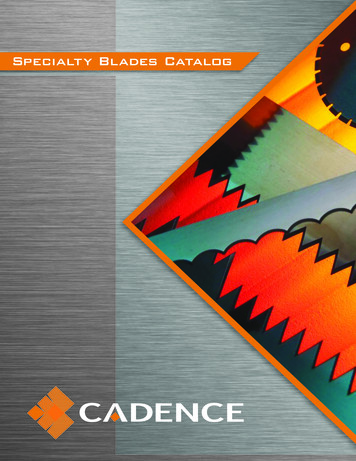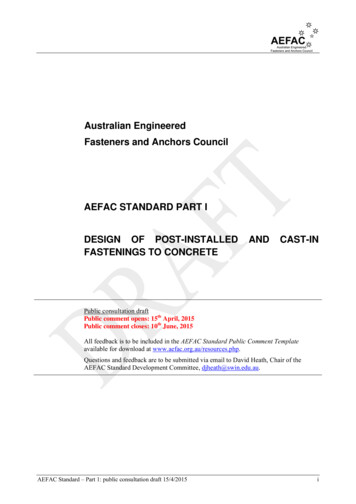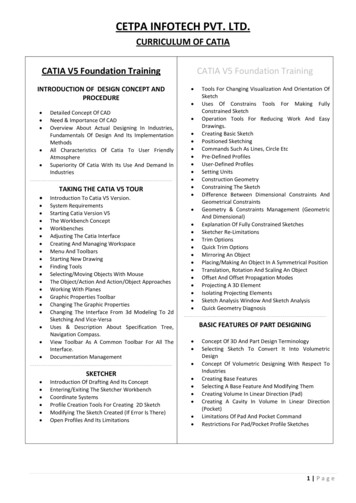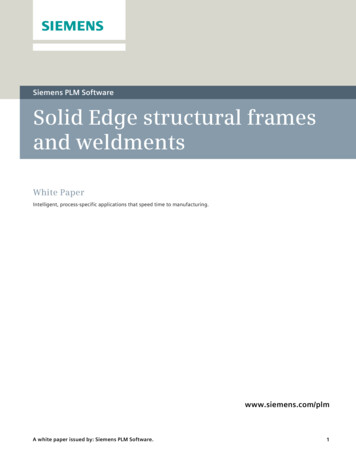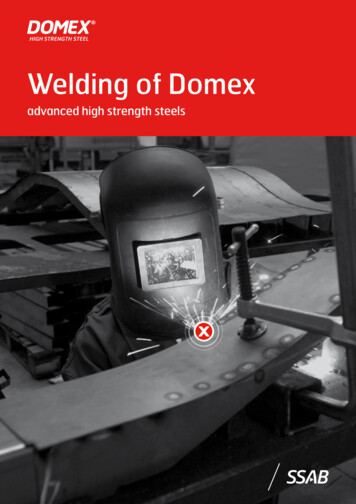
Transcription
1 A Router pRimerEdge & SurfaceTreatmentsby Nick EnglerRouters were developed to cutmoulded shapes in wood.Although their workshop role hasexpanded (greatly) during the lastcentury to include joinery and otheroperations, moulding is still whatthey do best. They remain the chiefwoodworking tools for edge and surface “treatments” – cutting decorative shapes.Before we get into the techniquesfor making decorative mouldedshapes, let’s review these shapesand how they’re combined. In manywoodworkers’ minds, this is muddywater. Open any tool catalog tothe router bit section and you’llfind whole pages of shapes, all ina jumble. But don’t worry. There issome order to this chaos.Despite the profusion of mould-pro tipSafe Small ProfilesSmall (1 2" wide or less) profiles and edge treatments can be dangerous to run.To avoid this, use a two-step process. By preparing a slab of wood the appropriate thickness of your profile (let’s call it a 1 2" x 10" x 24" piece of cherry) you cansafely run the profile on one long edge, then head to the table saw to safelycut off the thin edge piece. Then head back to the router table and repeat theprocess. It adds a couple of steps, but it also adds a lot of safety.46E d g e & S u r f a c e T r e a t m e n tsing bits, there are really only threeshapes in decorative woodworking: Bead (convex curve) Cove (concave curve) Flat (straight line)Every moulding, no matter howcomplex, is comprised of beads, covesand flats. If you had only three routerbits – one for cutting beads, one forcutting coves, one for cutting flats –you could still produce any shape ofmoulding, no matter how intricatethe shape.
Basic moulded shapestips & tricksFillet or listelChamferBevelUse straight bitUse chamfering bitor V-bitUse chamfering bitor e or cavettoUse V-bitUse fluting bitUse fluting bitUse cove bitUse straight bitTwo Sides of Grooves MakePretty Decorative PanelsQuarter-roundbeadHalf-round beador astragalUse roundover bitUse beading bit forsmall beads, nosing orroundover bit for largebeadsBasic Moulded ShapesOf course, there’s a little more to it.Each of these three main categories is subdivided into a few basicmoulded shapes that can be cut witha common bit. All mouldings arevariations or combinations of thesebasic shapes, shown in the illustrations above.There are no hard and fast rulesdictating how you combine theseCyma rectaCyma reversaUse ogee bit (centersof curves are alignedhorizontally)Use ogee bit (centersof curves are alignedvertically)shapes or how you use them. However, you may find these guidelinesuseful: Consider where people willstand when viewing the shapes andpresent these features at an anglethat makes them easy to be seen andenjoyed. Vary the shapes in a complexmoulding – don’t just repeat thesame shapes over and over. The clasThis tabletop will seea lot of use, so thewoodworker whomade it cut a thumbnail moulding in theedge. This relativelysimple shape preserves the strengthof the edge, while amore complex shapewould weaken it andthe edge would soonshow the wear.Cut a set of grooves in a board thatare parallel to each other. Makeeach groove a little more than halfas deep as the board is thick. Thenturn the board upside down and cutanother set of grooves at an angleto the first set. Where the groovesintersect, they will create openings.The size, shape and spacing of theseopenings depends on the size, shapeand spacing of the grooves.Simple Cock BeadingCock beading is a simple edge detailthat can dress up doors, drawersand much more. But cutting thisdetail on a door panel can be a lotof work. The simple option is to runa quantity of 1 8" hardwood throughyour router table adding a bullnosedetail to one edge. Then, simply gluethis edging to your panel. Presto –simple cock beading.T h e U l t i m a t e R o ut e r G u i d e47
a R o u t e r Pr i m e rWhen you’re ready to shape your workpiece,first cut the end grain along the ends then cut the long grain along the edges.To make an appliedmoulding or pictureframe stock, cut theshape you want inthe edge of a wideboard, then rip it tothe proper thickness,which I’m doing hereon my table saw.Don’t try to rout ashape in narrow stock– it may chip, splinteror kick back at you.This safety consideration also appliesto making curvedmouldings, suchas a classic “gooseneck” moulding. Cutthe inside curve in thewide moulding stock,sand it so the curvesare fair, then rout theshape in the edge.When you’ve shapedthe inside edge of thestock, you can cut theoutside edge to freethe moulding fromthe piece, as I’m doinghere with my bandsaw.sic bead moulding, which incorporates a cove and a bead, has been afavorite of cabinetmakers for hundreds of years – you hardly ever seea moulding with a double cove or adouble bead. To make mouldings moredramatic, use sharp, crisp transitionsbetween the shapes. Make the curvesand flats meet at distinct angles, oryou can use fillets to separate shapes. If the structural strength ofthe piece is important, use simplershapes.Once you have designed a moulding, you need to plan how you’llmake it – what bits to use, how manypasses you’ll need to make, etc.Then, consider how to incorporatethe moulded shapes in the project you’re building. You have twochoices: You can cut the shapes intothe surfaces of the structural parts,or you can make separately shapedparts (mouldings) and apply them tothe piece.Each of these choices has tradeoffs. If you make applied mouldings,you may not be able to match thewood grain and color of the largerpiece, but you can use moulding todisguise seams and joints. If youcut the shapes in a large structuralpiece, you don’t have to worry aboutmatching the wood, but you do haveto worry if the shape will weaken thepiece. Choose whichever mouldingdesign works best for the piece.Cutting with the RouterWoodworkers usually shape theedges of a piece. The reasons forthis are both aesthetic and practical.Because the edges often trace theoutline of the project, shaping the48E d g e & S u r f a c e T r e a t m e n ts
edges emphasizes and enhances thedesign. Also, the edges are easier tocut than the faces.The technique for routingmoulded edges is simple andstraightforward; there’s little herethat hasn’t already been explained inprevious chapters. However, a fewadditional considerations are worthmentioning.Before you rout a shape in astraight edge, make sure that theedge is as smooth and even as possible. Joint it and remove all the millmarks. If the edge is contoured,make sure all the curves are “fair” –smooth and even. Because one of thepurposes of a moulded shape is toemphasize the edge, the shape alsowill emphasize any imperfections inthe edge.When you’re ready to shape thepiece, cut the ends (end grain) first,then cut the edges (long grain).Cut the large parts with a handheld router, and cut the smallerparts on a router table. With verysmall parts, leave them attached toa larger board, rout the edge of theboard, then cut the parts free. Thislast technique is particularly important when making mouldings. Mostmouldings, when ripped to theirfinal dimensions, are too slenderto rout safely. The cutting action ofthe router may actually tear the thinstock apart.If you use a large bit such as apanel-raising bit, slow down thespeed of the router. The larger thebit, the slower you should run therouter – otherwise the bit may burnWhen cutting straightgrooves, you can usea variety of jigs to geta decorative effect.Here, a tapering jigproduces a pattern ofangled grooves in atable leg. The groovescreate the impressionof a tapered leg, eventhough it’s straight.tips & tricksSubtle RefinementEdge treatments don’t have to becomplicated to be effective. A simpleroundover bit or chamfering bit inthe right locations can soften thelook and feel of a piece of furniture,adding an extra level of elegance.And either of these bits work wellwith a bearing guide in an easy-tomanage trim router.Keep That Piece ClampedDown TightWhenever you’re routing something,make sure that either your workpiece or your router is stable andsecure – they can’t both move. If youchoose to move the router across thework, clamp the work to your bench.If a clamp interferes with the operation, rout up to it and turn the routeroff. Then move the clamp to an areaon the workpiece that you’ve alreadycut and resume routing.Back-routing (Also Known asClimb-cutting) Can be ToughOccasionally you must back-rout apiece to reduce tear-out. This meansyou are cutting with the bit’s rotation, rather than against it. It’s muchmore difficult to control your workthis way, so be sure to take shallowcuts and feed very slowly. Keep therouter and the work steady, makingsure the bit doesn’t chatter.T h e U l t i m a t e R o ut e r G u i d e49
a Router primertips & tricksthe wood. If you can’t vary the speedof the router, you shouldn’t use bitslarger than 2" in diameter. Even bitslarger than 11 2" can be troublesome.Surface TreatmentsLayers Can Help if You WantComplex MouldingsInstead of making multiple passesto create a complex moulding, justglue up several simpler shapes. Theeasiest way to do this is to “laminate” the shapes – or build them upin layers. But you can also “join” theshapes by cutting dados, rabbetsor grooves in the moulding stock,then glue smaller strips of wood inthese joints. The strips that you gluetogether don’t have to be the samespecies – you can use contrastingwood, if you want.How Much is Enough?To make sure the collet is safelygripping a router bit, insert 3 4" ofthe length of a 1 4" shank bit into thecollet and insert a full 1" of every 1 2"shank bit.Bits Pull Double DutyIn addition to cutting edges, youcan create a variety of decorativeshapes in the face of your workpiece.Surface treatments can be cut prettyTemplateSome surface grooves are simultaneouslydecorative and practical, such as the groovearound the perimeter of this cutting board.Not only does it collect liquids, but thegroove also adds visual interest to an otherwise uninspiring piece. To make this groove,cut a template from hardboard and secure itto the cutting board with double-sided tape.Then you can cut the groove using a guidecollar and core-box bit, keeping the collarfirmly pressed against the template.Most edge-profile router bits aredesigned to be run in a specificorientation to the edge. However, ifyou’re looking for an unusual alternative, don’t hesitate to think in adifferent dimension. By running thewood past the bit in a vertical ratherthan horizontal attitude, the profileis changed subtly. And you get twoprofiles out of one bit.50E d g e & S u r f a c e T r e a t m e n tseasily with either a hand-held or atable-mounted router fitted witheither an unpiloted or a point-cut bit.The most common surface decoration is a simple groove – flat-bottom,round-bottom or V-bottom. If thegroove is straight, use a straightedge,fence or miter gauge to guide the cut.If the groove is irregular, you’ll wantto use a guide collar and a template.For decorative grooves with amore-complex geometry, you canmake multiple passes – or use amore-complex bit. For example, bymaking multiple parallel passes witha point-cut roundover bit (sometimescalled a “beading” bit), you can formcock beads and reeds. Or, you canmake cuts with a veining bit or around-nose bit to create flutes. Also,a point-cut ogee bit will rout a widegroove with a double-ogee shape.Making Complex MouldingsWhen you produce complex mouldings, you often make multiple cuts,combining edge and surface treatments. It isn’t difficult, but there are
Make multiple passes with a beading bit tocreate decorative reeds and beads in thesurface of a board. Because the beading bit isactually a small point-cut quarter-round bit,each pass cuts a 90 arc – one-quarter of acircle. Half-round beads require two passes.The corner bead or reed on this table legrequires three passes because it is threequarters round.Point-cut bits with a complex shape, suchas this pilotless ogee bit, cut a broad groovewith an interesting shape. The sides of thegrooves are mirror images of each other.A flute is just a half-round groove – the opposite of a half-round bead. Often, it’s blind at oneor both ends. Use a veining bit to cut the flute and a straightedge to guide your router. If theflute is blind, it helps to have a plunge router. Attach stops to the straightedge to halt the cutwhen the flute is the correct length.tricks to help you. First, you will need to decidewhich router bits to use to cut thedifferent shapes. Often this is moreof an art than a science. There maybe three or four bits in your selection that will produce a single shape.Knowing which one will work best isa matter of experience. Second, when you know whichbits you’re using, carefully plan thecuts. Each cut should leave enoughstock to adequately support theworkpiece during the next cut. Ifpossible, make small cuts beforelarge ones, and remove stock fromthe interior or middle of the surfacebefore taking it from the sides. Third, when you make each cut,use constant, even pressure to feedthe work (or move the router) andkeep it firmly against the guides.If the pressure isn’t constant or ifthe work wanders slightly, the cutmay not be even. If the problemcontinues over several passes, theremay be considerable variation in themoulded shape along the length ofthe board. Fourth, make more mouldingthan you think you’ll actually need,because if you run short, it will bedifficult to reproduce the exact samesetups you went through.Inlaying BandingYou can decorate wooden surfaces bycutting shallow mortises and fillingthem with inlaid strips of veneer,patches of marquetry and parquetry,slabs of mother-of-pearl, strands ofwire and so on.Because these inlaid objects oftenare small and intricately shaped,cutting mortises to fit them requiresprecision. Not only must the shapebe correct, the depth must be accurate and absolutely uniform. That’swhy one of the best tools for makingthese small cuts is the router.Perhaps the simplest type ofdecorative inlay is the inset woodT h e U l t i m a t e R o ut e r G u i d e51
a Router primera bit of adviceThese bits are great when using yourrouter to make edge & surface treatments.Panel-raisingBitThis bit combines two smallwings (whichcut downwardto shear thetop edge) withtwo large wings(which shearupward for a smooth finish). It’s idealfor creating decorative tops andshould be used in a router table.Beading BitThese bits addan attractiveprofile to furniture and millwork. They canbe used to cut allkinds of material – plywood,hardwoodand softwood.They’re alsoavailable withsteel pilots orbearings for similar designs.banding. These simply are ribbons ofwood sliced from a board or a sheetof veneer.They also may be made up ofseveral contrasting colors of wood,forming long strips of marquetry(designs that are made with multiplepieces of wood arranged with thelong grain showing) or parquetry(multiple-piece designs with the endgrain showing). They are usuallystraight, but they also may be curved.To inlay straight banding, firstmeasure its width and thickness.Then rout a shallow rabbet, dado orgroove to fit it, using either a handheld or a table-mounted router.After cutting the recess, just glue thebanding in place. For more details,check out the photos at right.If the inlaid materials are fairlythick, you’ll want to rout a recessthat is slightly shallower than theinlay is thick. This will make theinlay “proud” when you glue it inplace – meaning it will protrudeslightly above the surface of thewood. After the glue dries, scrape orsand the inlay flush with the surface.If the inlaid materials are thin,you risk sanding through them ifyou mount them proud, as explainedabove. Instead, you will need torout the recess to precisely the rightdepth. Use dial calipers to measurethe thickness of the inlay, then carefully adjust the router’s depth of cutto match.Cut recesses for banding with the same setupyou would use to cut simple rabbets, dadosand grooves. If the workpiece is small, cut iton your router table using a fence to guidethe board. If the workpiece is too large tohandle on the table, use a hand-held routerand clamp a straightedge to guide the router.Either way, a straight bit is the best choice.Next, test-fit the banding in its recess. Whenyou’re satisfied with the fit, spread glue inthe recess and press the banding in place.Wipe away any excess glue, place a piece ofwax paper or plastic wrap over the bandingand clamp a straight, thick board to the pieceover the covering. The board helps distributeclamping pressure evenly, and the coveringkeeps it from sticking.Table Top BitThis bit,designed withsharp curves,helps you generate a strong,uplifting edge,creating a boldeffect on allkinds of furniture.52E d g e & S u r f a c e T r e a t m e n tsWhen the glue is dry,remove the board andthe covering, thenscrape away any gluethat remains on thesurface. But be careful you don’t scrapetoo deeply – youdon’t want to scrapethrough the banding.
Dado & Rabbet JigSome banding inlays simply are thin piecesof wood ripped from boards or cut fromsheets of veneer. You can make these simplebandings in your workshop, using a saw or aknife. Other inlays can be intricate pieces ofmarquetry. These are made by arranging different colors of wood in geometric patterns,gluing them together and slicing them intolong ribbons. You can make these yourself,too, if you have the patience, but there aremany ready-made marquetry bandings available from mail-order suppliers.This jig simplifies the set-up and the operation necessary to make repetitivecuts. Just lock the board between the base and clamping bar, then guide therouter along the bar. The stock doesn’t move, so you don’t have to worry aboutcontrolling a large piece of wood, and the straightedge doubles as the clamp,so the set-up is very simple.The jig is just two pieces of wood (a base and a clamping bar) with the sizesdetermined by your needs. Make the base from 3 4" plywood and the clampingbar from a hard, dense wood such as oak or maple. The bar should be fairlythick so it doesn’t bow when tightened. I crowned the top and bottom surfacesof my clamping bar, making it 1 32" to 1 16" thicker in the center than at the ends.Even though the bar flexes, the clamping pressure remains even.To use the jig, position the stock on the base under the clamping bar. To dothis quickly and accurately, it helps to make a positioning gauge from a scrap ofthin plywood or hardboard. Lock the bar down on the base and place the scrapso that one edge rests against the side of the bar. Rout all the way through thescrap, creating a strip about as long as the bar. The width of this strip is thedistance from the edge of the router to the bit’s cutting edge.Use the positioning gauge to align thestock underneath the clamping bar. Theedge of the gauge indicates the insideedge of the cut.This jig also is a timesaver for making identical cuts in multiple parts. To make multipleidentical cuts, such as the cheeks and shoulders of tenons, clamp a short fence to thebase to position the parts.Exploded viewClamping barWhen inlay materials are thick, you can rout arecess to make the inlay “proud,” then sand itflush. When inlay materials are thin, you risksanding through them if you mount themproud. Instead, use calipers to measure theinlay thickness, then adjust the depth of cutto match.Attach self-stick#100-grit sandpaper tobottom edge3 8" x 5" carriage bolt, flat washer,0.030" x 13 32" I.D. x 3 4" long compression spring and wing nut (2 setsrequired)BaseT h e U l t i m a t e R o ut e r G u i d e53
tipS & tRickS Subtle Refinement Edge treatments don’t have to be complicated to be effective. A simple roundover bit or chamfering bit in the right locations can soften the look and feel of a piece of furniture, adding an extra level of elegance. And either of these bits work well with a bearing

